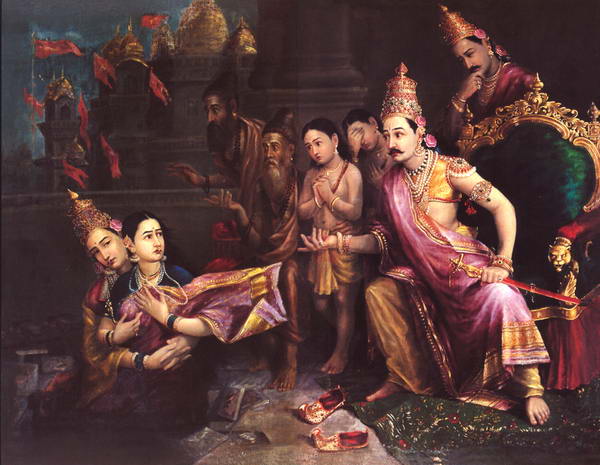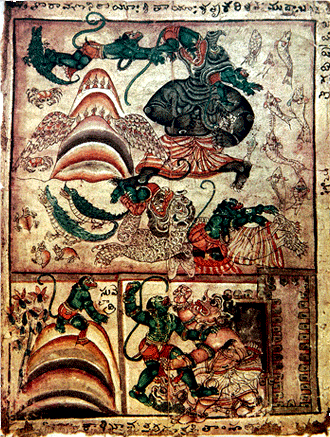In his grief he made a golden statue in his wife's image, and kept in in her living quarters of the palace. King Rama never had eyes or lust for another woman, for Sita was the only one he was destined to be with. When Lava and Kusa had sung of his adventures in the Ramayana, he knew that these were his sons, for they were in his likeness.
Rama sent Lakshma to Valmiki's home, and the next day it was arranged that Sita would return to Adyodha and the great festival will end. The crowd had gathered early in the morning, and Rama had Sita's golden statue returned to the kingdom during the night. The Queen entered the crowd of people, as beautiful as ever, and Rama held his breath in excitement. Instead of embracing Rama, though, Sita had asked her husband permission to prove her innocence once again. This was granted, and Sita asked her Mother to take her back to her underground home for good. Before Rama could object, Mother Earth rose to the surface and looked to all of the crowd, her husband (Janka), and her lovely daughter. Mother Earth had lost patience with Rama and his people, took Sita in to her lap, and they disappeared underground. All the people of the crowd rejoiced for Sita's innocence, but deep in Rama's heart he was sad that he would not see Sita every again. He took this as an act of Karma, and brought his sons home when the festival ended.

When Rama returned to Ayodha, he went to Sita's living quarters to see if her statue was still there. It was, and he had decided to keep it standing there for his sons and his sanity. Another 1,000 years had passed, and Time requested that Rama return heaven where all the gods were awaiting his arrival. Rama agreed and made preparations for this. He called his ever faithful servant Hanuman and asked him, "My most devoted follower, will you accompany me on my journey to heaven?" Hanuman was surprised with this request, and it took him a minute to gather his thoughts. Eventually Hanuman replied, "My King, as delightful as this sounds, I believe that it is my mission in life to remain on Earth as long as there are ears yearning to hear about your great deeds in the Ramayana. I must make sure that scribes and storytellers only tell the story in 100% truth. Look how after 10,000 years of ruling, the men of your very own kingdom have turned their backs on Sita, although the Ramayana tells of how she remained innocent while in captivity." Rama realized that Hanuman was right, and was very grateful that he was willing to take this task upon himself. Rama replied, "Hanuman, for your unbreakable devotion to me and my kingdom, I grant that after my leave you will take possession of the golden statue made in Sita's likeness. You are the only one that I trust enough to ensure to tell of her braveness, loyalty, and significance in the Ramayana." After this was decided, Rama felt better about leaving his kingdom behind. The great King departed for his last journey to Sarayu and onto heaven. Hanuman was there to see him off, and had only happiness in his heart for the King that he loved deeply.

A few days after Rama's depart. Hanuman created a temple for anyone in any region of the Earth to come and hear about the Ramayana. He created a shrine for Rama and Sita, and in the place of Sita was the golden statue created previously. Anytime Hanuman would lay eyes on the shrine, or told another about the adventures of the great king, his heart was filled with gladness.
Author's Note:
For this story, I tried telling about the fate of Sita's golden statue after Rama had departed for heaven. Throughout reading this version of the Ramayana, it bothered me that Rama left her in the forest, even after I read the ending and learned that it was for "the good of the kingdom." When looking over storytelling prompts, I thought that it was interesting that we do not find out what happens to the statue in the end. I decided that since Hanuman was such a devotee of Rama, and that he was the one to find Sita in Ravana's garden, he would be the one to receive and care for the statue. I felt that if anyone else were to be put in charge of it, it would have eventually been neglected. I also thought about how over time the citizens of Ayodha forgot how courageous Sita was while waiting for Rama to save her, and felt that if someone like Hanuman did not continue to tell the Ramayana in its true form that Sita's name would once again be defamed.
Bibliography:
Buck, William (1976). Ramayana: King Rama's Way.








